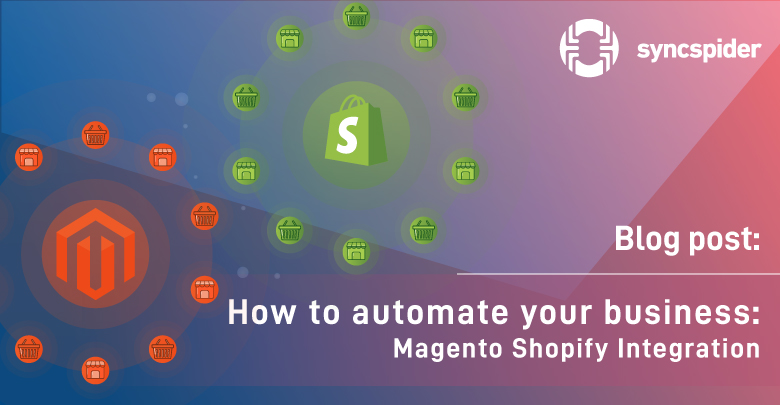Magento Shopify Integration process with SyncSpider
If you want to sync Magento (1 or 2) and Shopify store, you can easily integrate these two with SyncSpider iPaas solution.
All you have to do is to go through the 4-step procedure:
- Connect both apps – Magento Shopify Integration requires connecting them through the SyncSpider system.
- Choose the action – You are the creator of synchronization. Therefore, you choose which actions will be performed. You can send customer details, orders, categories, or product details from Magento to Shopify and vice versa.
- Select a trigger – SyncSpider offers you the option to choose when the action will be performed and what will trigger it. You can create your unique workflow and select the actions performed in intervals, on schedule, or when some change happens.
- Sit back and relax! – Well, we guess there’s no need to explain this one. Your eCommerce business is automated after connecting, choosing the action, and setting a trigger. You have more time to spend on tasks that matter and let the automation do tedious work.
What are Magento and Shopify?
Magento is a popular eCommerce platform that uses open-source technologies and allows users (sellers) to create, change, or update their online stores.
Shopify is a cloud-based eCommerce platform with a user-friendly interface, making it very suitable for beginners.
Market share and advantages/disadvantages
Both of the eCommerce platforms are among the top 5 eCommerce platforms, and they both have advantages and disadvantages.
Depending on the budget, scale of business, target market, and other factors, users will opt for one of these two. Of course, they are not the only platforms available for eCommerce, and therefore the choice might become even more challenging.
What’s Magento’s share?
According to the latest statistical data, Magento takes 2.32% of the world’s eCommerce market share, and it is one of the top 10 eCommerce platforms globally.
It is the most frequently used shop software in the UK eCommerce, 25% of the top 500 online shops by net sales in 2020 in the UK, It is also in first place in Germany (19%), and it’s among the top 5 in the USA.
What’s best about Magento?
Though Magento may seem a bit complicated for those not familiar with eCommerce platforms, it offers vast possibilities to the users, which is why it’s one of the most popular platforms for creating brands.
- Unlimited customization – Due to its high flexibility and open architecture, the user can create a customized eCommerce shop that 100% corresponds with the vision and business needs.
- Advanced Functionalities – The robust system offers various functionalities. The users can view, create and edit orders from the admin panel; they have the options of multiple invoice printing, call-center support, shipping labels, email notifications, and an RSS feed for new orders.
- Analytics available – The success of your business will largely depend on the analytics. If you can track how many orders you have, what products are in-demand, the state of your stocks, how many potential buyers visited your shop, etc., it will be much easier to manage your business and make decisions.
- Multiple payment options – It’s up to users which payment option they will offer to their buyers. Magento provides a single-click payment, billing purchases for later, checkout without registration, simple registration, multiple payment options, and many other valuable features.
- Easy integration – Magneto is easy to integrate with ERP systems, other sales channels, and SEO and digital marketing tools. Using some of the tools, such as SyncSpider, you can easily synchronize all data and conduct multi-channel sales effortlessly.
- High security and data protection – The Magento 2 offers a GDPR extension to help online stores comply with the latest legislative requirements and strengthen data security and privacy.
What’s best about Shopify?
- Simplicity – Shopify has a highly user-friendly interface, making it easy to use even if you have no prior experience opening an online shop.
- It’s hosted platform – Which means you don’t have to think about hosting providers. Everything you need is within the platform you use.
- No coding – One of the best things about Shopify is that there is no need to know coding to set up your online store. You can do that without writing one single line of code.
- Analytics – Shopify users have access to various types of analytics, such as financial reports regarding taxes, sales, payments, real-time information, inventory reports, overview reports regarding sales, orders, sessions, user behavior reports, and analytics for campaigns.
- SEO-friendly – Shopify offers an excellent SEO tool that users can customize most of their SEO parameters.
- Design functionality – The users can choose templates (free or paid) without designing them from scratch (which is always an option if none of the templates fit).
What are the disadvantages of Magento?
- Complexity – Magento is, as mentioned previously very complex and robust system. It requires developers and testers to set up a store.
- It takes time – Setting up a store with Magento is a process, and getting a customized store takes time.
- Hosting issues – Since Magento is a robust system, it will take up a lot of space, and therefore it’s necessary to pay attention when choosing a hosting provider. Shared servers are not the best solution since sometimes they might slow the site.
What are the disadvantages of Shopify?
- No free version – One of the disadvantages of Shopify is that there is no free version. The users need to pay for at least the basic plan to start their online shop.
- Associated apps fee – To use most of the features of your Shopify store, you will have additional expenses.
- Complicated integration processes – According to Trustradius reviews, some users experience difficulties integrating apps, other eCommerce platforms, or payment gateways. Though, the solution to this problem already exists. The users can overcome the issue by using SyncSpider, a tool for easy integration and synchronization of various apps, databases, and platforms.
What’s the difference between Magento and Shopify?
There are several differences between Magento and Shopify.
- Magento is self-hosted, and Shopify is hosted platform – Which means if you are opening a store with Magento, you’re going to take care of hosting yourself. On the other hand, if you open a store on Shopify, you will not have to think about hosting costs and everything related to it.
- Magento has a free option, and Shopify only commercial – This means that if you want to open a store on Shopify, you will have to pay between US$29 and US$299 a month, depending on the plan you choose. In contrast, by choosing Magento Open Source, you can open your store for free. Of course, you will have to pay the hosting and domain provider. On the other hand, if you choose Magento Commercial version, you will have to pay a certain amount, depending on the scale of your business.
- Shopify is suitable for beginners, while Magento requires some developing skills – Since Magento is an open-source technology platform packed with features, beginners might find it challenging to start using it. Meanwhile, Shopify offers a simple and user-friendly interface suitable for eCommerce beginners.
- Shopify has more varieties when it comes to design – Today, in January 2022, Shopify has 13 free and 71 paid design templates, while Magento offers 2 free and 4 paid templates. Though it provides more than 3,500 extensions, it still narrows the choices you have.
How to integrate Shopify with other apps by using SyncSpider?
If you want to integrate Shopify with any other app, or eCommerce market, by using SyncSpider, you have two options for that, and they both begin by creating a SyncSpider account.
- Connecting SyncSpider to Shopify via API – After opening a SyncSpider account, find Shopify on the list of integrations by choosing the app icon or inputting the name in the search bar. The next step is to write the name of the app and a short description, and after that, it is required to generate Shopify’s API key. Getting an API key is possible by logging in to your Shopify account. Shopify provides a detailed explanation of how to do that. After generating API, the Shopify account needs to be adjusted, and the process is explained in one of the Help articles on our site. After opening access to SyncSpider in your Shopify store, you will be able to connect it to any other app from our integrations list and synchronize data.
- Connecting SyncSpider to Shopify via Public app – Connecting SyncSpider to Shopify through a Public app is a more convenient method. Still, it’s possible only for users who have admin access in their Shopify store. It is a more convenient and accessible way of connecting since it’s done directly from Shopify’s app.
How to integrate Magento with other apps by using SyncSpider?
Just as with Shopify integration, the primary step in the integrating process is opening a SyncSpider account. After that, Magento users can connect Magento with SyncSpider and, through it, connect to any other app from the list.
Magento has two versions, Magento 1 and Magento 2.
Magento 1
Since Magento 1 had its last update in 2018, and since June 2020 is no longer officially supported, and there are still more than 140.000 websites using Magento 1.9, it might be helpful to migrate to Magento 2, Shopify, or any other eCommerce platform.
Magento 1 is on the list of available integrations on SyncSpider, which means you will be able to migrate your data once the SyncSpider is connected to your Magento 1 store. Integration is done through Magento 1 extension zip file, which is unpacked locally and copied to the Magento root directory. The whole procedure is described in the Help article on our site.
Magento 2
Magento 2 integration has a similar path as Magento 1. However, the user will be asked for the URL address of the Magento 2 shop at the very beginning. That there are two options for the integration process.
The first one is through the downloading and pasting method, and the other is by installing using a composer. The detailed procedure is described in the Help article on our site.
The most popular Magento & Shopify integrations
Shopify users typically search for the solution for integration of their Shopify store with WordPress, QuickBooks, Amazon, Etsy, Xero, and Klaviyo.
While Magento users mostly ask for integration with WordPress, and some of the payment getaway options or shipping software.
But if your business needs require some unique and customized solution, SyncSpider can provide you with that on a request. We offer more than 350 integrations, and if an app you want to integrate with your Shopify store is not on the list, you can always reach out to our support and ask for it.
Magento Shopify integration
Though it’s not common to use Magento and Shopify simultaneously, there are cases when Magento Shopify integration is necessary. And that typically happens when the users want to migrate data from one source to another (for various reasons).
The migrating process can be exhausting, primarily if it encompasses much data. Therefore, the best way is to implement an integration tool that enables automated migration from source to target without manual input.
It provides an easier and faster solution and lowers the chance of mistakes. And if you want to explore new possibilities, you can check out the top 5 online platforms for eCommerce in 2022 and make a smart decision.












